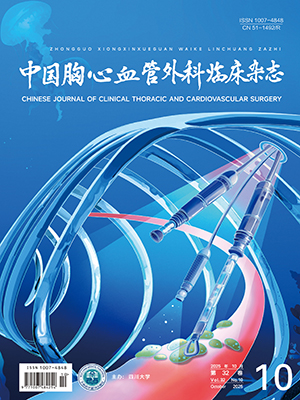| 1. |
Cui Z, Suo C, Zhao Y, et al. Spatiotemporal correlation analysis for the incidence of esophageal and gastric cancer from 2010 to 2019: ecological study. JMIR Cancer, 2025, 11: e66655.
|
| 2. |
Bray F, Laversanne M, Sung H, et al. Global cancer statistics 2022: GLOBOCAN estimates of incidence and mortality worldwide for 36 cancers in 185 countries. CA Cancer J Clin, 2024, 74(3): 229-263.
|
| 3. |
Zheng RS, Chen R, Han BF, et al. Cancer incidence and mortality in China, 2022. Zhonghua Zhong Liu Za Zhi, 2024, 46(3): 221-231.
|
| 4. |
Cao W, Chen HD, Yu YW, et al. Changing profiles of cancer burden worldwide and in China: a secondary analysis of the global cancer statistics 2020. Chin Med J (Engl), 2021, 134(7): 783-791.
|
| 5. |
Jiang Q, Shu Y, Jiang Z, et al. Burdens of stomach and esophageal cancer from 1990 to 2019 and projection to 2030 in China: findings from the 2019 Global Burden of Disease Study. J Glob Health, 2024, 14: 04025.
|
| 6. |
王雪婷, 姚卫光. 2010-2021年中国食管癌死亡率变化趋势分析及预测研究. 中国全科医学, 2024, 27(1): 1-10.Wang XT, Yao WG. Trend analysis and forecasting study of esophageal cancer mortality rate change in China from 2010 to 2021. Chin Gen Pract, 2024, 27(1): 1-10.
|
| 7. |
曹毛毛, 李贺, 孙殿钦, 等. 2000—2019年中国胃癌流行病学趋势分析. 中华消化外科杂志, 2021, 20(1): 102-109.Cao MM, Li H, Sun DQ, et al. Epidemiological trend analysis of gastric cancer in China from 2000 to 2019. Chin J Dig Surg, 2021, 20(1): 102-109.
|
| 8. |
GBD 2019 Diseases and Injuries Collaborators. Global burden of 369 diseases and injuries in 204 countries and territories, 1990-2019: a systematic analysis for the Global Burden of Disease Study 2019. Lancet, 2020, 396(10258): 1204-1222.
|
| 9. |
胡守财, 陶堰成, 马浩天, 等. 1990-2019年中国非风湿性瓣膜性心脏病疾病负担及变化趋势分析. 中国循环杂志, 2024, 39(8): 806-812.Hu SC, Tao YC, Ma HT, et al. Disease burden and changing trend of non-rheumatic valvular heart disease from 1990 to 2019 in China. Chin Circ J, 2024, 39(8): 806-812.
|
| 10. |
李辉章, 杜灵彬. Joinpoint回归模型在肿瘤流行病学时间趋势分析中的应用. 中华预防医学杂志, 2020, 54(8): 808-813.Li HZ, Du LB. Application of Joinpoint regression model in cancer epidemiological time trend analysis. Chin J Prev Med, 2020, 54(8): 808-813.
|
| 11. |
Danpanichkul P, Suparan K, Tothanarungroj P, et al. Epidemiology of gastrointestinal cancers: a systematic analysis from the Global Burden of Disease Study 2021. J Gastroenterol Hepatol, 2025, 74(1): 26-34.
|
| 12. |
Hemminki K, Zitricky F, Försti A, et al. Survival improvements in esophageal and gastric cancers in the Nordic countries favor younger patients. Cancer Med, 2024, 13(15): e7365.
|
| 13. |
Ilic I, Zivanovic Macuzic I, Ravic-Nikolic A, et al. Global burden of esophageal cancer and its risk factors: a systematic analysis of the Global Burden of Disease Study 2019. Front Oncol, 2025, 15: 24.
|
| 14. |
Ren F, Shi Z, Shen X, et al. The global, regional, and national burden of stomach cancer attributed to smoking in 204 countries, 1990-2019: a systematic analysis for the Global Burden of Disease Study 2019. Tob Induc Dis, 2024, 22: 1-10.
|
| 15. |
Qin N, Fan Y, Yang T, et al. The burden of gastric cancer and possible risk factors from 1990 to 2021, and projections until 2035: findings from the Global Burden of Disease Study 2021. Biomark Res, 2025, 13: 5.
|
| 16. |
Hu J, Dong H, Dong Y, et al. Cancer burden attributable to risk factors, 1990-2019: a comparative risk assessment. iScience, 2024, 27(4): 109430.
|
| 17. |
Etemadi A, Poustchi H, Chang CM, et al. Exposure to polycyclic aromatic hydrocarbons, volatile organic compounds, and tobacco-specific nitrosamines and incidence of esophageal cancer. J Natl Cancer Inst, 2023, 116(3): 379-388.
|
| 18. |
Wu S, Chen Y, Chen Z, et al. Reactive oxygen species and gastric carcinogenesis: the complex interaction between Helicobacter pylori and host. Helicobacter, 2023, 28(6): e13024.
|
| 19. |
Duan Y, Xu Y, Dou Y, et al. Helicobacter pylori and gastric cancer: mechanisms and new perspectives. J Hematol Oncol, 2025, 18: 10.
|
| 20. |
Zhu H, Wang Z, Deng B, et al. Epidemiological landscape of esophageal cancer in Asia: results from GLOBOCAN 2020. Esophagus, 2023, 14(11): 992-1003.
|
| 21. |
Jiang Y, Lin Y, Wen Y, et al. Global trends in the burden of esophageal cancer, 1990-2019: results from the Global Burden of Disease Study 2019. Ann Transl Med, 2023, 15(2): 348-364.
|
| 22. |
谷变利, 马丽霞, 石林林, 等. 食管癌流行病学研究现状及展望. 食管疾病, 2024, 6(2): 148-151.Gu BL, Ma LX, Shi LL, et al. Advances and prospects in epidemiological research on esophageal cancer. J Esophageal Dis, 2024, 6(2): 148-151.
|
| 23. |
Lowe KA, Katz A, Kelsh MA, et al. A multinational assessment of gastric and esophageal cancer burden by age, gender, and disease characteristics. J Clin Oncol, 2015, 33(3_suppl): 29.
|
| 24. |
Zhang T, Zhang Y, Leng X. Global, regional, and national trends in gastric cancer burden: 1990-2021 and projections to 2040. Gastric Cancer, 2024, 14: 1-14.
|
| 25. |
胡守财, 杨成龙, 马浩天, 等. 1990—2019年中国饮酒所致的食管癌疾病负担趋势及男女对比分析. 中国胸心血管外科临床杂志, 2025, 32(4): 500-507.Hu SC, Yang CL, Ma HT, et al. Trends in Chinese esophageal cancer burden of disease due to high alcohol use and comparative analysis of males and females from 1990 to 2019. Chin J Clin Thorac Cardiovasc Surg, 2025, 32(4): 500-507.
|
| 26. |
Jackson SS, Marks MA, Katki HA, et al. Sex disparities in the incidence of 21 cancer types: quantification of the contribution of risk factors. Cancer, 2022, 128(19): 3531-3540.
|
| 27. |
Sun LP, Yan LB, Liu ZZ, et al. Dietary factors and risk of mortality among patients with esophageal cancer: a systematic review. BMC Cancer, 2020, 20: 287.
|
| 28. |
Uhlenhopp DJ, Then EO, Sunkara T, et al. Epidemiology of esophageal cancer: update in global trends, etiology and risk factors. Clin J Gastroenterol, 2020, 13(6): 1010-1021.
|
| 29. |
Inoue M. Epidemiology of gastric cancer: changing trends and global disparities. Cancers (Basel), 2024, 16(17): 2948.
|
| 30. |
Zhang L, Dong Q, Wang Y, et al. Global trends and risk factors in gastric cancer: a comprehensive analysis of the Global Burden of Disease Study 2021 and multi-omics data. Int J Med Sci, 2025, 22(2): 341-356.
|




